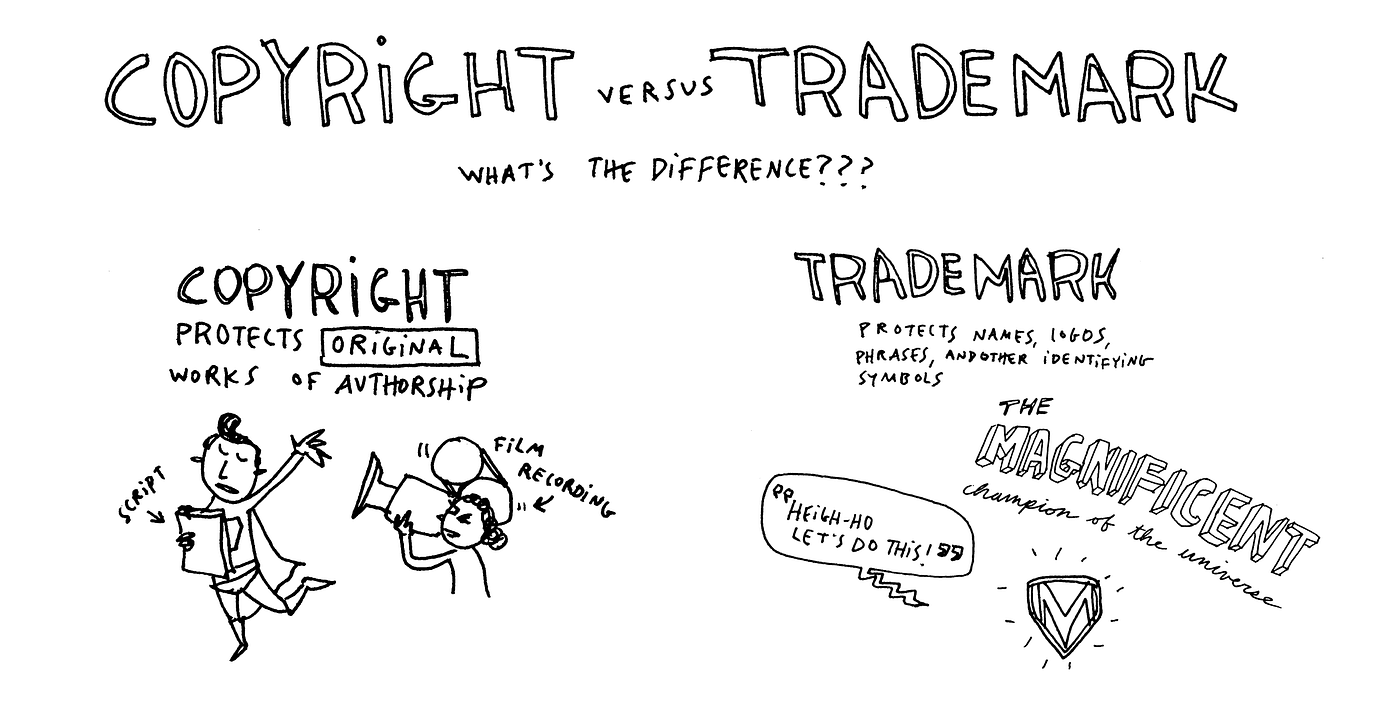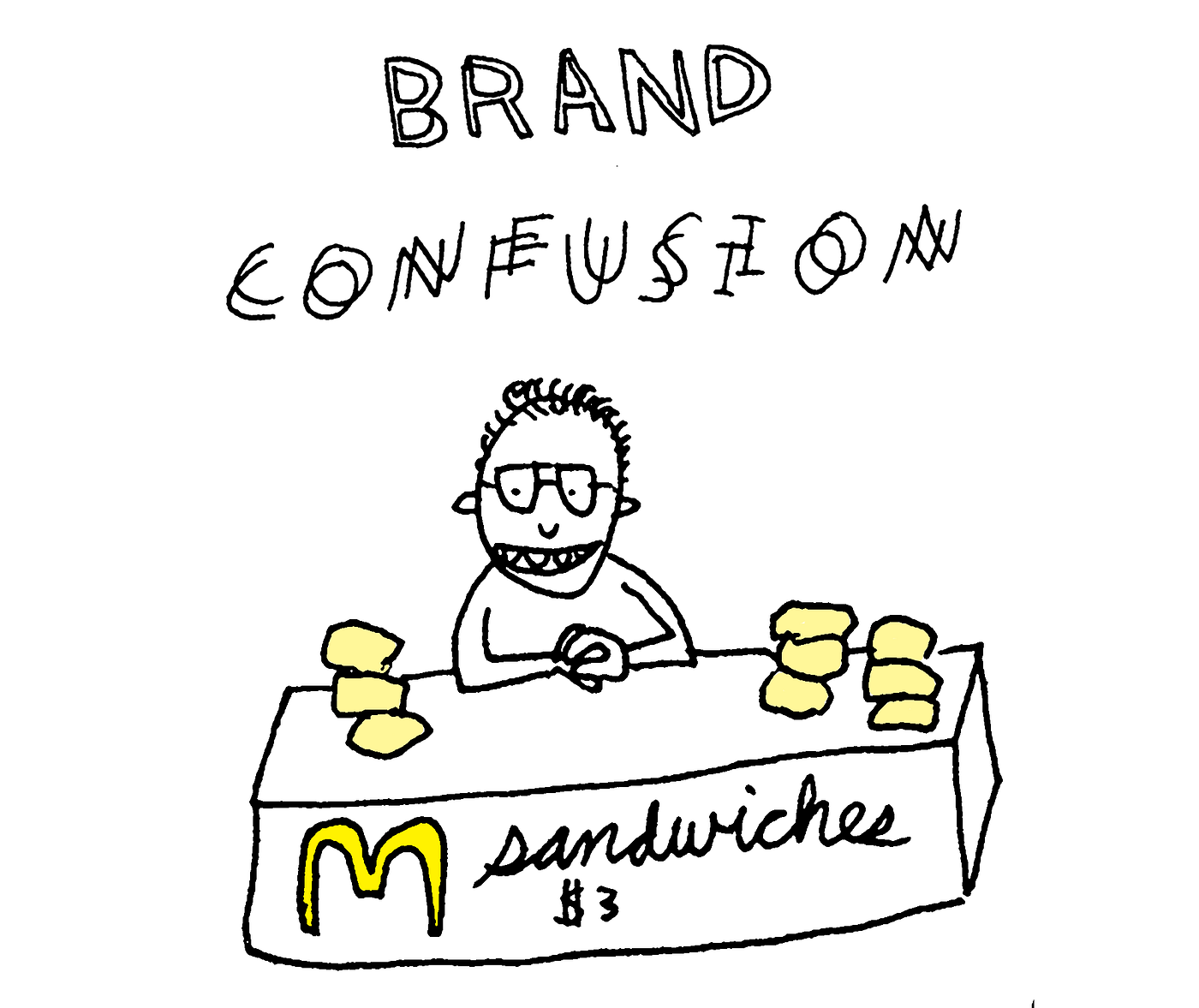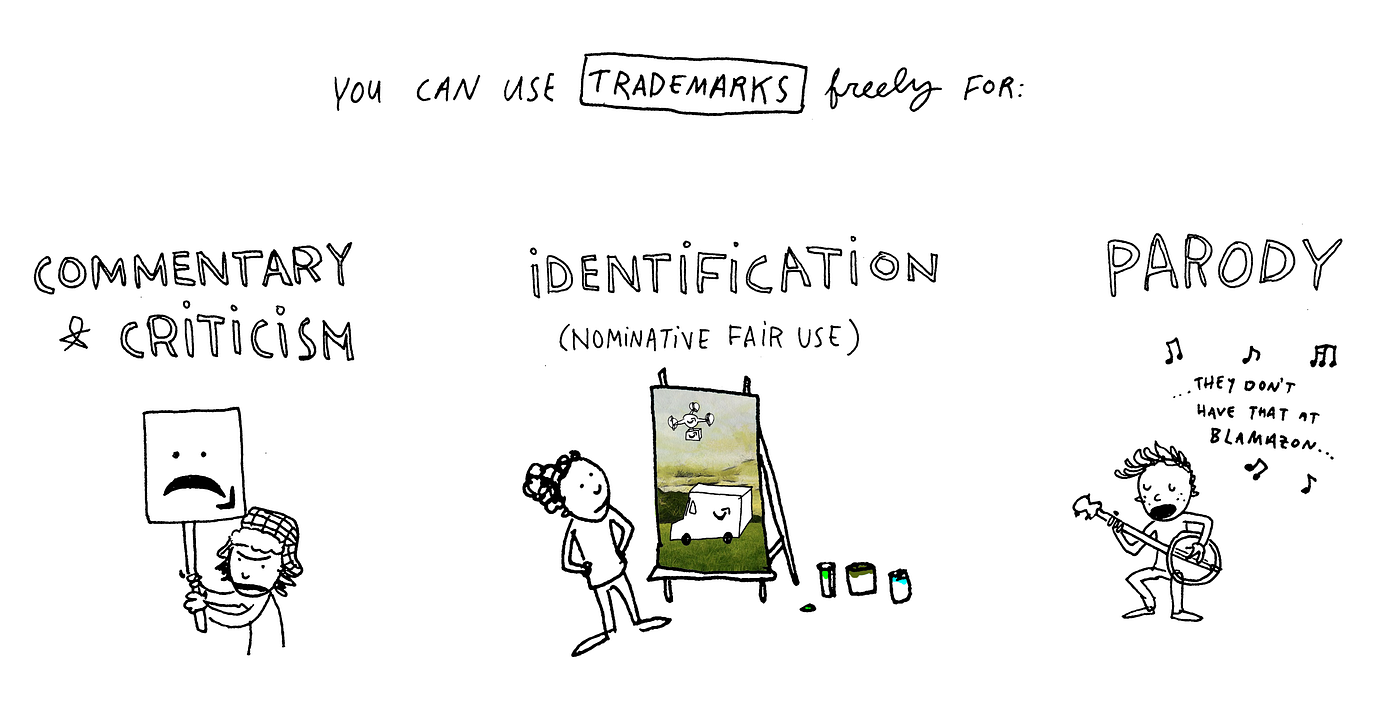Can I Sue for Trademark Infringement if Someone Uses My Art?
The Cyberlaw Guide to Protest Art: Trademark
This is the Trademark section of the Cyberlaw Guide to Protest Art. It covers what trademark protects, and when you can employ another person's trademark (with or without their permission). To get an overview of the complete Guide, visit the Roadmap, or link to the other sections here:
- Copyright Part i: what copyright protects (and what it doesn't) and how to deal with copyrighted works
- Copyright Part 2: the law of fair apply — what information technology is, how it'due south adamant, and the risks of fair employ
- Copyright Part three: getting permission to utilise the piece of work of others — how to place a copyright owner and how to make a license request
- Rights of privacy and publicity: legal rights of privacy and publicity, which are implicated when protestation fine art features real people
- Sharing and merchandising your piece of work: licensing your work including with Creative Eatables, using disclaimers, and making money
What Is Trademark?
A trademark is a discussion, symbol, or phrase used to place and distinguish a particular manufacturer or seller'southward product. The Nike "swoosh," McDonalds arches and Adidas stripes are all examples of registered trademarks. Trademarks can take the form of a brand proper name, logo, slogan, or some combination thereof.

For trademark protection, a marking must be recognizable enough that the consumer will recognize the brand or manufacturer. This means that something generic, like an American flag logo for a company that sells American flags, would non qualify for registration. However, more than specific phrases, similar "Sweatsuit Nation" or "Mission Mountain Gun Owners" would exist eligible.
What does trademark protect?
The possessor of a trademark has the exclusive right to use it in commerce, which means they're the only person who can utilise that word, logo, or phrase to brand a profit. If someone other than the trademark owner is selling something and uses the trademark in a way that'due south probable to confuse a consumer about the brand or manufacturer, the trademark possessor tin sue them for trademark infringement.
For case, if a graphic designer with the terminal proper name "MacDonald" were to develop a logo— say, a curvy yellow "M" — to feature on his website header and equally a signature on his artwork — it would probably exist okay. However, if the aforementioned designer subsequently tried to produce a line of snacks or nutrient products featuring his new "Thousand" logo, it's not hard to guess who might file a trademark infringement suit in response. The "Chiliad" logo combined with the "MacDonald" proper noun used in connexion with nutrient products would almost certainly confuse consumers about the origin of the products — they might call back that McDonald's (of the Golden Arches fame) were somehow affiliated with the graphic designer's new snack line.

Why register a trademark?
While a copyright automatically exists in most creative works, trademarks must be registered with the U.Due south. Patent and Trademark Function (USPTO) to receive full legal protection.¹
If the owner of a registered trademark thinks her marking is being infringed anywhere in the state, she may sue in federal court. If the trademark possessor is able to evidence infringement, bachelor remedies include:
- A court order that the defendant stop using the trademarked material
- A court social club requiring the destruction or forfeiture of infringing articles
- Monetary relief, including the accused'southward profits or amercement sustained by the plaintiff
- Payment of the plaintiff'southward attorney's fees
Yous can tell a mark is registered past use of the symbol "®".
However, owners of common law or unregistered trademarks do still have some rights. An unregistered mark will not receive as much protection — for example, the owner of an unregistered trademark can simply assert her rights in the geographic market in which her business concern already operates. She can't enforce her rights in other cities and states. If the owner thinks that someone is copying her unregistered trademark, she will normally be able to sue in state court, merely not federal court, and she may not be able to collect budgetary relief or recover attorney'south fees. Typically, an unregistered trademark owner'southward remedies are limited to injunctive relief — that is, a court society demanding that the infringer finish using the mark, only no money amercement. You tin tell an unregistered mark by apply of the symbol "™".
When Tin can You Apply Another Person's Trademark?

Commentary and criticism
As a general rule of thumb, you can utilize trademarks freely for commentary and criticism.
For instance, an creative person could use the Barbie logo in artwork critical of Barbie'due south unrealistic beauty standards, and the possessor of the trademark wouldn't be able to silence him. Yet, this is but true as long every bit there is no adventure of confusion between the artist and the trademark owner. In other words, information technology has to exist articulate that the Barbie trademark owner has non created or endorsed the artwork. The same artist would open himself up to infringement liability if he used the Barbie trademark once again in an unrelated context — say, materials promoting the campaign of a blonde politician. A consumer might be confused by the reference to Barbie and conclude that that the Barbie trademark owners were involved in promoting the candidate.
Nominative fair use
You can also use a trademark in the context of nominative fair use. This is a technical term for a concept that'due south not likewise technical at all. When you need to use a trademark to identify a product so you can talk well-nigh it, that's nominative apply. This legal doctrine acknowledges that sometimes we need to utilise trademarks to exist clear when nosotros're talking almost another party's products or services, and not because we're trying to profit off of that use. If musician were to write a song about big corporations intruding on the market for local java shops, she might notice it necessary to reference sure trademarked products, like a Frappuccino®.
Parodies
Yous can too utilize trademarked elements in parodies, equally long equally the parody is not tied as well straight to commercial utilize. In 1 parody-related lawsuit, the federal court described trademark parody as a cultural necessity:
"Trademark parodies, fifty-fifty when offensive, exercise convey a bulletin. The bulletin may be simply that business and product images need not always exist taken too seriously ; a trademark parody reminds us that we are free to laugh at the images and associations linked with the mark ." ²
However, just like with commentary and criticism, courts will consider the likelihood of consumer confusion in determining whether a parody uses trademarked cloth accordingly. Your parody tin can evoke the original merely must clearly not be the original (i.east., it must be something new, commenting on the original). For example, a court concluded that a pornographic parody of Star Wars was not infringing the Star Wars trademark because it merely evoked the original, and the likelihood of consumer confusion was modest.
Also similar to criticism, your parody must be aimed at the trademark owner or their appurtenances and services, not an unrelated third party or consequence. For example, a parody using the Nike trademark must be aimed at Nike (its products, business practices, etc.). You tin can't only use the Nike mark to criticize some other company or person in a more attention-grabbing way.
Again, if your parody confuses consumers (i.east., they believe the trademark owner created or sponsored your piece of work), you may exist liable for infringement. This ways when you are trying to sell something or make a profit, you should tread more carefully around others' trademarks — retrieve that courts will likely view creative and editorial parodies more favorably.
Read More!
- Roadmap: an overview of the complete Guide
- Copyright Part 1: what copyright protects (and what it doesn't) and how to deal with copyrighted works
- Copyright Part 2: the constabulary of off-white employ — what information technology is, how it's determined, and the risks of fair employ
- Copyright Part 3: getting permission to use the work of others — how to identify a copyright owner and how to make a license request
- Rights of privacy and publicity: legal rights of privacy and publicity, which are implicated when protest fine art features real people
- Sharing and merchandising your work: licensing your work including with Creative Commons, using disclaimers, and making money
[1] We are assuming yous wish to use and annals a trademark in the US. Other countries' trademark laws are significantly unlike.
[2] L.L. Bean, Inc. v. Drake Publishers, Inc., 811 F.second 26, 34 (1st Cir. 1987).
The information in this guide is intended for background educational purposes and its authors are not your lawyers. For more information, please click here .
Source: https://medium.com/@cyberlawclinic/the-cyberlaw-guide-to-protest-art-trademark-91f673079d82
0 Response to "Can I Sue for Trademark Infringement if Someone Uses My Art?"
Post a Comment